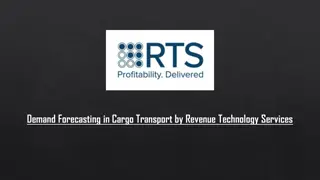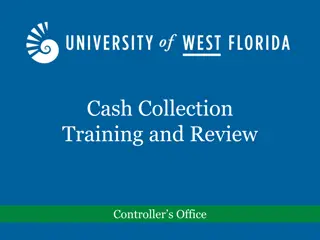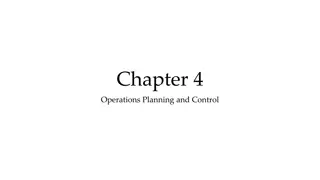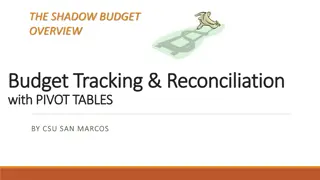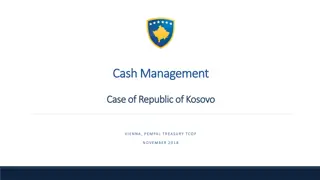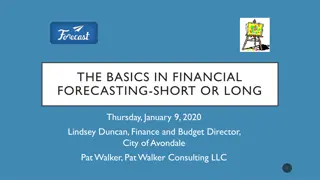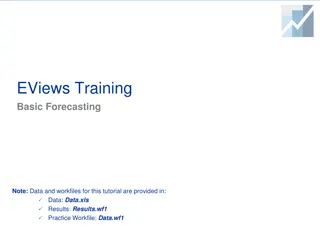Efficient Cash Flow Forecasting for Government Financial Management
Efficient cash flow forecasting is vital for government financial management to ensure budget targets are achieved, expenditures are smoothly financed, and potential problems are detected early. By forecasting daily cash flows, governments can manage their cash efficiently, optimize cash balances, reduce borrowing costs, and earn interest on surpluses. Cash flow forecasting helps in active cash management, annual budgeting, debt monitoring, and optimizing cash utilization. It also aids in controlling spending profiles, identifying short-term cash requirements, and aligning revenue forecasts with budget targets.
Download Presentation

Please find below an Image/Link to download the presentation.
The content on the website is provided AS IS for your information and personal use only. It may not be sold, licensed, or shared on other websites without obtaining consent from the author. Download presentation by click this link. If you encounter any issues during the download, it is possible that the publisher has removed the file from their server.
E N D
Presentation Transcript
Cash Flow Forecasting: why, how and for what? PEMPAL Treasury Community of Practice Vienna, November 2018 Mike Williams mike.williams@mj-w.net 1
Outline Building the Forecast: Tools and Techniques Cash Forecasting and Cash Planning Data and Resources Using the Forecast Annexes added on Building the Cash Plan; Forecasting in selected countries; a Revenue template; and tasks of the CMU 2
Cash Flow Forecasting Efficient cash management requires ability to forecast daily cash flows across the TSA 1. To facilitate orderly achievement of budget targets; to ensure that budgeted expenditure is smoothly financed avoiding delays; and to give early warning of any problems 2. To devise the strategies for active cash management A smoother cash flow means: Lower average cash balances Reduced net borrowing costs Interest on cash balances always less than interest on marginal borrowing Interest can be earned on any temporary cash surpluses Less pressure on central banks monetary policy operations Characteristic of all modern government cash management systems 3
Some Distinctions Suggested definition: Cash flow forecasting is the process to estimate future government cash inflows and outflows, with a view to taking action necessary to ensure that sufficient funds are always available to meet any net government cash requirements; and, in any period where there is a net cash surplus, to ensure that it is used to best advantage. Forecasting the annual and multi-annual fiscal position (deficit/surplus, financing) Annual Budget Agreeing monthly profiles for budget execution & monitoring Budget profile Forecasting [daily] net flows to help debt and cash managers In-year Forecasts The budget profile is important to calibrate the budget, prepare the financing plan and monitor performance. It can control appropriations. It should be updated regularly and sets the framework for in-year forecasts; but they have a different purpose 4
Financial Programming and Cash Flow Forecasting Cash Flow Forecasting Forecasts independent of control totals what will happen not what should happen Two objectives Ensuring that cash is available when required, with no risk of cash rationing Minimising use of cash over the period ahead Often managed separately from budget execution processes Financial/Cash Programming Linked to budget execution Forecasts based on budget profiles Profiles often linked to appropriations Revenue forecasts may also be constrained to budget target Two objectives: Controlling spending profile to ensure cash availability Identifying short-term cash requirements and surpluses Risk confusing targets/ controls with forecasts Both are needed see Annex on building the cash plan 5
Outline Building the Forecast: Tools and Techniques Cash Forecasting and Cash Planning Data and Resources Using the Forecast 6
Developing Cash Flow Forecasts Start from budget profiles but systematically revise, collecting latest information Build independently of budget process Treasury (or Debt Office) not Budget Department Avoid game playing by MDAs Must focus on what will happen, not what should happen Cash in and out of TSA May be different from recording of revenue and expenditure Focus is domestic currency (DX) Unless FX/DX interface is seamless May need to identify FX, donor flows separately (depends on TSA structure) Objective is to anticipate cash needs 7
Cash Flow Forecasting: the Horizon Ideally Monthly profile for the year, regularly updated, supports budget execution But more detailed forecasts looking at least 3 months ahead Monthly, then weekly, then daily Rolled forward regularly (monthly, then weekly) Including over year-end Forecast information is needed for some period ahead Timing of future peaks and troughs must be identified to make decisions about financing or seeking other sources of cash; If cash rationing or withholding of allocations is necessary, it gives time to develop response Giving time for MDAs to adjust avoids more damaging unplanned cash delays 8
Building the Forecast Identify seasonality, explore patterns Monthly salary payments; regular social welfare or pension payments Some other expenditures eg agricultural support may be seasonal Tax payment days Drawing on previous years experience (see below) How to handle end-year surge? Identify major individual flows Some are very precise Tax payments by the largest companies Debt servicing (also some donor receipts and grants) Transfers to lower levels of government Payments on major public projects Build contacts with large Project Offices Line Ministries and Revenue Authorities must cooperate 9
Line Ministries, Revenue Agencies and the Forecasts Cooperation of LMs and RAs is essential Insist on forecasts or intelligence about latest information If necessary, legislate Focus only on RAs & larger LMs (80/20 rule) [and also PMOs for investment expenditure] LMs cover non-tax revenues Scope for Carrots and Sticks? Cash penalties/incentives Virement flexibility League tables Simple templates, rolled forward regularly Personal contacts Avoid requests / information going up hierarchy, across and down Cash forecasters in Treasury must have direct contact with opposite numbers in major LMs and RAs New intelligence (early notice of divergences from forecasts or unanticipated flows) as important as regular updates 10
Cash Forecasting: Information Network Line Ministries, Revenue Agencies advise on expected and actual flows Budget, allocation, cash ceilings Historical patterns, models etc Regional Treasury Offices Debt Interest --------------- Debt Principal: borrowing & repayments from debt office Aggregate revenue and expenditure forecast GIFMIS Outturns & Commitments Actual TSA balance from central bank (data on other bank deposits?) Other financing transactions (asset sales, grants) Cash Balance Forecasts 11
The Role of Econometrics Econometric models are important for multi-annual projections & annual budget Early warning indicators of macro- economic activity can be useful in- year Some expenditures may be linked to macro or other variables (weather & agricultural support) Difficult to develop models that will generate a monthly or quarterly path Some other Approaches Model underlying trend on which is imposed estimated seasonal adjustments; but not always been an improvement on more simple pattern analysis. Some (e.g. Peru) have explored autoregressive models, relating revenue in one month to revenue in same months in previous years, plus a macro variable and trend factor (and/or tax changes) There are always special factors (policy changes, behavioural shifts) to take into account, and changes from year to year in the day on which month ends or key holidays fall. 1. 2. 3. => Experience, intelligence networks and pattern analysis usually more productive Average past patterns: use for homogenous flows or when there is no better information Separate profiles for different streams; be wary of using for capital expenditure Identify past outliers, one-offs or deviations from average Take account of end of months on a weekend, dates of public holidays, etc 12
Use Past Patterns Carefully! Averaging can overlook some big fluctuations Timing effects can be significant in different years The size of the end-year surge can vary 13
Another Example Something unusual in 2014! 14
Identifying Maximum Cumulative Outflow within the Month The example of a country where there is a sharp outflow during the month before any inflow (real country data) Monthly forecasts hide the within-month profile Meeting the cash requirement for the month may still leave a cash shortage in some weeks Hence the need for weekly and daily forecasts or identify maximum outflow during month The example of Italy (from Public Debt Report 2014) 15
Some Other Techniques Scope to link days of outflows to days of inflows? Particular problems with external flows (inc. EU grants?) Payment due dates for new taxes linked to e.g. salary payment dates Smoothing salary payments across the month Avoid bond redemptions on days/weeks of weak cash flow Identify preferred date for privatisation receipts; fix dates of e.g. transfers to local governments Inflows before outflows within the month Requires close interaction with other functions Highly uncertain, difficult to forecast, may depend on project progress Possibly assume project spending and project funding net to zero (but lumpy flows? Or direct payments) Inflows may also go to separate accounts (donor or FX accounts) not TSA 16
Outline Building the Forecast: Tools and Techniques Cash Forecasting and Cash Planning Data and Resources Using the Forecast 17
Forecasting: Resources Responsibilities of a CMU (for Forecasting) People Forecasting does not require many staff Small forecast unit (maybe only 2- 3 people) Function may be split Between those responsible for forecasting revenue and expenditure and those for financing Or by task: pattern analysis; database management; liaison with MDAs, central bank etc Must identify responsibility for aggregating forecasts and identifying policy options [Highly active cash management may need more resources] Prepare forecasts of government cash flows and cash balances for the next [3 months] to be circulated [every two weeks] to senior management [and members of the relevant committee] Advise senior management: on the risks associated with the forecasts (including sensitivities) on the implications for future borrowing programs or financing options, taking account of previously-agreed financing plan on other action (including transfers between DX and FX Accounts, or delays in payment processing). [Potentially] Secretary to [the relevant decision-making committee] 18
Analysing Forecast Performance and Errors Essential part of the forecasting task Planning responses to forecast deviations Learning lessons for the future Explore: What does the error in any one period say about the future will the divergence be sustained or correct itself. Need advice from LMs & RA Timing changes: do errors in one week tend to be reversed in the next; is there evidence of serial correlation in the past Do errors in different series offset each other. May be affected by cash rationing. (Explore standard deviations*) It is the cumulative error that matters and feeds into the calculation of the cash buffer * Standard error of sum of independent variables is square root of sum of the standard deviations, squared, of each variable. Example: Is StDev [Revenue-Expenditure] >/< [(StDevRev)2+(StDevExp)2] 19
Forecast Performance Cumulative error is important Forecast appears too pessimistic Over-performance does not tell us much about risks Forecast should be an unbiased estimate allowance for caution should be explicit Advantages of graphical presentation; has implications for the way in which data are maintained 20
Managing Forecast Data Large volumes of data Forecasts, profiles, returns from MDAs/RA, analyses (do not overwrite successive forecasts) Forecasters have to: Aggregate returns, incorporate other info, prepare scenarios, policy options Usually use Excel at least initially Flexible, under cash managers control, data do not have to be of accounting quality, speed is of essence But easy to amend accidentally: requires care and back-up Link to GIFMIS for outturn info Possibly also to collect forecasts, some use e.g. SharePoint 21
Commitment Controls and Forecasting To manage the initial incurrence of obligations, instead of subsequent cash payments to enforce expenditure ceilings and avoid expenditure arrears The key objectives of commitment controls Some commitments have multi-period cash implications Cash plans ensure that commitment ceilings are consistent with the projected cash availability (and vice versa) Cash planning on its own will be ineffective unless it is integrated with control over commitments Effective commitment controls must be linked with cash plans Ideally identifies a formal due date for payment; or at least an indicative date Capturing commitment of top 5-10% payments by value will cover 90% of expenditure But variable lags => commitment information not itself sufficient for cash flow forecasting Forecasts make use of commitment information - gives indication of future cash requirements 22
Continuing Challenges in Many Countries Lack of systematic collection of outturn data Different budget and accounting classifications Fragmentation of IT systems hampering data aggregation Excel becomes unwieldly and lacks robustness Past cash rationing implies distorted historical spending data Tax forecasts tend to be more difficult than spending Not always capital expenditure very difficult liaise with PMOs Problem of end year surge (end-year flexibility or similar mechanism) Poor coordination with other functions to help smoothing Cash & debt management often institutionally/geographically distant Poor coordination with central bank no exchange of forecasts Confusion between budget execution and liquidity management Not enough performance analysis MDAs are lazy just divide by 12 23
Outline Building the Forecast: Tools and Techniques Cash Forecasting and Cash Planning Data and Resources Using the Forecast 24
Putting the forecast to work Supporting cash management Smoothing the TSA; targeting a range of fluctuations Policy focus on short-term borrowing and investment Helps monetary policy; but cash flow forecasts still need to be passed to the central bank Supporting budget execution Cash flow forecasts identify the cash profile a few months ahead More realistic than profiles => may be different Are cash resources are adequate to deliver the budget? May imply delaying release of allocations (or delaying payments) In the event of cash rationing, decisions should take account of budget priorities informed by budget department Deciding spending priorities and processing individual payments is separate from decisions about financing and usually require different people/functions 25
Managing Deviations from Forecast Deviation Timing Change Sustained Vary Tbill issuance More Cash Less Cash 1. Increase planned issuance 2. Sale of assets, FX to DX 3. Rationing/revised budget 1. Build cash buffer in TSA or banks 2. Reduce planned issuance. 3. Buy back debt/long-term savings 26
Cash Coordinating Committee Useful and widely used coordination mechanism for short-term cash management decisions Meets weekly, chaired e.g. by Head Treasury Including also budget division, macro-fiscal unit, debt managers, central bank, tax authorities, possibly large spending ministries Delegated authority for decisions within agreed parameters Main responsibilities: Review cash flow outturns, and the comparison with forecasts Review cash flow forecasts for the period ahead Decide on action needed to ensure cash adequacy over the period ahead Supported by Cash Management Unit (CMU) Responsible for forecast preparation, database, error analysis etc Also preparation of scenarios and what-ifs Policy recommendations (discussed with debt managers) 27
Presenting the Forecast 1/2 Prepared by: [name] Note: Some months will have 5 weeks, or 4 weeks plus a stub, depending on the convention adopted Circulated on: [date] For meeting of [CCC] at [end Sept] Reference [as required] All figures rounded to 0.1 million local currency Forecast Outturn to end Week 3 month 9 (Sept), estimated outturn week 4 Month 10 October Month 11 November Month 12 December Sept- wk1 Sept- wk2 Sept- wk3 Sept- wk4 Oct- wk1 Oct- wk2 Oct- wk3 Oct- wk4 Nov- wk1 Nov- wk2 Nov- wk3 Nov- wk4 Dec- wk1 Dec- wk2 Dec- wk3 Dec- wk4 Notes 1 Opening TSA Balance Receipts 2 Current Receipts 3 Capital Receipts Payments 4 Salaries 5 Good and Services 6 Transfers 7 Other current expenses 8 Debt interest 9 Investimento 10 Deficit/Surplus Other Capital Flows 11 Redemptions (negative) 12 Grants 13 Other Financing 14 Loans and Credits 15 Tbonds (as previously announced) 16 Tbills (as previously announced) 17 Implied closing TSA Balance 8.2 Detail as required Detail as required Note: all figures below are illustrative only Detail as required Detail as required 0.6 0.2 8.7 6.9 0.6 0.6 0.6 0.2 9.1 0.2 7.9 0.2 9.4 0.2 7.3 0.2 6.2 0.2 7.6 0.2 9.3 9.0 7.7 11.4 6.9 7.3 6.9 6.9 28
Presenting the Forecast 2/2 Sept- wk1 Sept- wk2 Sept- wk3 Sept- wk4 Oct- wk1 Oct- wk2 Oct- wk3 Oct- wk4 Nov- wk1 Nov- wk2 Nov- wk3 Nov- wk4 Dec- wk1 Dec- wk2 Dec- wk3 Dec- wk4 Sensitivities/Contingencies 18 Persistent shortfall in revenue 19 Delays in grants received (timing only) 20 Assistance to flooded regions 21 Roads expenditure brought forward 22 Failed Auction 23 24 Implied closing TSA Balance (worst case) Possible policy options 26 Invest surplus cash, for 3 wks 27 Increase Tbill issuance 28 Extra Tbond auction, increase amount As necessary, delays in expenditure approval 30 31 32 TSA Worst Case Adjusted -0.3 -0.3 -0.3 -0.3 -0.3 -0.3 0.3 -0.3 -0.3 -0.3 -0.3 -0.3 -0.4 -0.3 -0.3 -0.3 0.4 -0.2 -0.2 0.1 -0.1 -0.1 -0.6 -1.0 -2.5 0.1 sub-total cumulative -0.3 -0.5 -0.3 -0.8 -0.7 -1.5 0.0 -2.5 -0.5 -3.0 -0.4 -3.4 -0.2 -3.6 -0.3 -3.9 -0.7 -4.6 -0.3 -4.9 -0.3 -5.2 0.1 -5.1 9.0 9.1 7.7 7.4 10.6 7.9 6.2 4.4 3.9 3.9 3.7 2.3 2.3 2.7 1.7 4.2 25 -1.0 0.1 -1.0 1.0 1.0 0.2 0.1 0.3 0.1 0.1 0.0 0.7 -0.6 0.7 29 0.2 -0.4 1.0 4.7 0.2 0.3 1.3 3.6 0.2 0.9 2.2 4.5 -0.6 -0.6 1.7 5.9 sub-total cumulative -0.9 -0.9 6.5 -1.0 -1.9 8.7 0.1 -1.8 6.1 1.0 -0.8 5.4 1.2 0.4 4.8 0.7 1.1 5.0 0.3 1.4 5.3 0.1 2.3 5.0 0.0 2.3 4.0 9.0 9.1 7.7 Implied closing TSA Balance 14.0 Implied closing TSA Balance (worst case) 12.0 10.0 TSA Worst Case Adjusted 8.0 6.0 4.0 Note Figures are arbitrary but intended to be realistic (weekly flows based on past AGD data) 2.0 0.0 Sept-wk1 Sept-wk3 Oct-wk1 Oct-wk3 Nov-wk1 Nov-wk3 Dec-wk1 Dec-wk3 29
Thank You! Annexes 1. Building the Cash Plan and a Typical Presentation 2. Some Forecasting Examples 3. An Example of a Revenue Forecasting Template 4. Tasks of the Forecasting Unit 30
Annex 1: Building the Cash Plan Agreed annual budget, turned into [monthly] profiles: Based on returns from line ministries and revenue agencies, constrained to budget totals Data on debt servicing, guarantees redeemed etc from Treasury/MoF Treasury may also want to check against its own profiles (see below) In some countries profile represents ceiling (can potentially be increased on request from Ministry Net cash position (bottom line) will: Provide check on the realism of the budget Identify financing need [to the extent that options available] Authority to spend released in line with profiles Cumulative during the year (subject to revised budget) Cash released consistently with profiles but only advanced when needed, reduced if any under execution Commitments as well as cash need to be monitored Early warning of major payments France: AFT must be informed of payments > 1 mn by 16.30 previous day Timely information on in-year outturns and other developments Every month or quarter, line ministries and revenue agencies resubmit profiles 31
Typical Annual Cash Plan Jan Feb Mar Apr May Jun Jul Aug Sep Oct Nov Dec Total Recurrent Revenues Direct Tax Indirect Tax Non-tax revenue Interest/profits/dividends Transfers/Grants Other Total Recurrent Revenues Detail as required A Recurrent Expenditures Salaries and allowances Utilities Other Good and Services Subsidies and transfers Other Expenditures Interest Payments Total Recurrent Expenditures This subtotal could be omitted if wished, moving straight to this one Detail as required B GFSM presentation that flows from above the line to financing or below the line items helps focus on policy options, mainly financing choices. A split between inflows and outflows is more difficult to interpret. Operating Cash Surplus +/Deficit - A-B=C Investment Cash flows Sale of Assets Capital Expenditures Net cash flows from investment Activities D Overall Cash Surplus +/Deficit - C-D=E Financing Cash flows Net Cash flows from Financial Assets Accounts Debt repayment/amortisation Gross new borrowing Total Financing Cash flows F Net Change in Cash (+ = inflow) F+E=G TSA Opening Balance Net change in cash (adjusted for non-TSA flows) Closing balance To reduce the size of this adjustment, all flows above should where possible be recorded by their impact on the TSA 32
Annex 2: Some Forecasting Examples UK Forecast above the line from within the Treasury daily looking 19 weeks ahead, rolled forward each month Line ministries provide daily forecasts 1 month ahead: incentivised by carrots & sticks Passed to DMO who add financing forecasts; take all borrowing/investment decisions USA Forecast up to 9 months ahead by Office of Fiscal Projections (part of Fiscal Service Bureau which in 2012 brought together the Financial Management Service and the Public Debt Bureau) Requires budget agencies to submit forecasts of varying detail also early warning large payments. France Daily forecast for 12 months prepared at beginning of year within AFT, updated during the year including with information from Budget Department and elsewhere Inclusion of municipalities and related organisations in TSA adds complexity to forecasting (managed through strict information rules) All spending units (inc lower levels of government) must inform AFT of all transactions greater than 1 million by 16.30 the day before AFT plans to be long of cash on the day 33
More Forecasting Examples Romania Forecasts prepared by Middle Office of DMU (DG Treasury & Public Debt) Daily forecast each month updated monthly, mostly top down on own experience (rather than approved cash plans) Spending transactions approved by local Treasury offices, visible to MO which updates daily forecast on the day Cash profile influences Tbill & Tbond issuance; also borrow from banks in middle of month to cope with outflow early in month Sweden Forecasts made within SNDO (DMO) Both bottom up and top down but focus on large flows only (rules for large transfers helps predictability) Monthly, then daily forecast based heavily on patterns, adjusted for macro factors, policy changes etc Aim for zero end of day balance in TSA (issue Tbills with odd maturities) 34
Annex 3: An Example of a Revenue Forecasting Template Authority Reference Date of Completion Contact All outturn figures rounded to nearest DX 0.1 million; all forecasts to nearest DX 1 million This example submitted [4] days before end June [as required] [by [4] working days before end month; or more frequently] [name, email etc] Note: "revenue" = cash flows into the Exchequer Account (ie net of retentions) DX Million Outturn to end Wk 18 Outturn (May) Estimated Outturn June Forecast July Forecast August Forecast September Weekly Forecast wk 19 wk20 wk 21 wk 22 wk23 wk24 wk25 wk26 wk27 wk28 wk29 wk30 wk31 wk32 wk33 wk34 wk35 wk36 wk37 wk38 wk39 Taxes on Income 423.1 16.6 18.7 22.9 45.7 28.7 32.3 39.5 79.0 18 22 16 19 32 20 22 22 47 31 34 34 71 649.8 27.3 30.7 37.6 75.2 27.8 31.2 38.2 76.3 30 35 26 32 53 33 36 36 76 33 37 37 77 Taxes on Goods and Services Total 1072.9 44.0 49.4 60.4 120.9 49.7 55.9 68.4 136.8 48 57 43 51 85 53 59 59 123 64 71 71 148 150 Taxes on Goods and Services DX mn Forecast 130 (Latest Approved) Budget Outturn to end April Var on May's forecast June Outturn May Monthly Summary Estimated Outturn 110 Taxes on Income July Aug Sept 90 70 Taxes on Income 1520.0 423.1 103.9 (-1.4) 179.6 110 113 181 50 2148.6 649.8 170.8 (+0.7) 173.5 170 174 190 Taxes on Goods and Services 30 Total 3668.5 1072.9 274.8 (-0.7) 353.0 280 287 371 10 wk27 wk33 wk39 wk20 wk23 wk24 wk25 wk26 wk28 wk29 wk30 wk31 wk32 wk34 wk35 wk36 wk37 wk38 wk 19 wk 22 -10 wk 21 Memo: latest approved budget profile 1079.3 278.6 342.9 284 293 353 Outturn (May) Estimated Outturn June Forecast July Forecast August Forecast September New worksheet for each submission, although some information will be repeated. Worksheet (and monthly forecast) rolls forward into next year Notes 1 2 3 Include some space for comment or other remarks, in particular to explain major changes Worksheets Mar-18 Apr-18 May-18 Jun-18 Jul-18 Aug-18 Sep-18 Oct-18 Nov-18 Dec-18 35
Annex 4: Tasks of the Forecasting Unit 1. Develop a [weekly/monthly] profile of agreed annual budget as a baseline for forecast preparation 2. Identify sources of information for updating the baseline, and developing forecasts for [3 months] ahead 3. Design forecast templates for [relevant contributors*]; prepare associated guidelines and instructional materials; and develop protocols for the supply of cash flow forecasts, consulting with [relevant contributors] and others 4. Make recommendations as necessary for tools (e.g. SharePoint) to receive or share forecasts; and to ensure their accurate aggregation 5. Ensure the receipt of cash flow forecasts from [chosen contributors] to format and timelines specified, following-up as necessary with responsible officials 6. Establish and maintain forecast and outturn data to detail specified; identifying any IT requirements, including back-up 7. Establish the flow of information from [Budget and Macro-fiscal departments] and others as necessary on any changes in expenditure, revenue or financing policies that might have implications for the profile of cash flows 8. Agree with Central Bank (and others) on: the procedures for movements between DX and FX accounts; and information flows between the Ministry and Central Bank (relating to forecasts and the TSA) 9. Develop a presentation of forecast data, sensitivities and financing options, that meets decision-makers requirements 10. Analyze divergences between forecast and outturn (and also divergences between plans and outturns) with a view to improving the accuracy of future forecasts 11. Analyze past expenditure and revenue patterns with a view to enhancing the accuracy of raw forecast data 12. Prepare a quarterly report for senior management [and members of the relevant committee] reviewing forecast performance and making recommendations for future improvement 36






